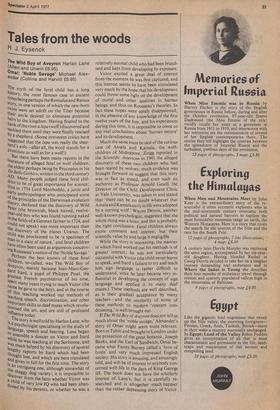Tales from the woods
H. J. Eysenck
The Wild Boy of Aveyron Harlan Lane (Allen and Unwin £6.95) Omal: 'Noble Savage' Michael Alexander (Collins and Harvill £5.95)
The myth of the feral child has a long history, the most famous case in ancient nnles being perhaps the Romulus and Remus story, in one version of which the new-born twins were set adrift on the Tiber because their uncle desired to eliminate potential heirs to the kingdom. Having floated to the bank of the river a lupa (wolf) discovered and suckled them until they were finally rescued by a shepherd. (Some irreverent critics have suggested that the lupa was really the shepherd's wife—after all, the word stands for a Prostitute as well as for a wolf!) But there have been many reports in the literature of alleged feral or wolf children, the oldest perhaps being by Procopius in his t2e Bello Gothico, written in the third century 'ID. Many people judged these feral children to be of great importance for science; thus in 1774 Lord Monboddo, a jurist and early anthropologist who anticipated some of the principles of the Darwinian evolution tbeory, declared that the discovery of Wild Peter (the brownish, black haired, twelveyear-old boy who was found running naked in the fields of a German farmer in 1724, and could not speak) was more important than the. discovery of the planet Uranus. The Child was proclaimed to be 'a specimen of Man in a state of nature,' and feral children !lave often been used as arguments concern-, Ing Rousseau's notion of the 'Noble Savage.' Perhaps the best known of these feral Children, so-called, was The Wild Boy of Aveyron, mainly because Jean-Marc-GasPard hard, a pupil of Philippe Pinel, the greatest French psychiatrist of his time, sPent many years trying to teach Victor (the name he gave to the boy), and in the course of this teaching worked out methods of teaching speech, discrimination, and other im.Portant skills to deaf mutes which revolunclnised the art, and are still of profound influence today. i The story is well told by Harlan Lane, who is a Psychologist specialising in the study of 'anguage, speech and hearing. Lane began to assemble a dossier on Victor and Itard while he was teaching at the Sorbonne, and as much helped by his discovery of several ,etrigthY reports by Itard which had been 'nought lost, and which are here translated
and given in full for the first time. The story 'San intriguing one, although somewhat of
t.h.e shaggy dog variety; it is impossible to alscover from the facts whether Victor was a, child of very low IQ who had been aban°°rIed by his parents, or whether he was a
relatively normal child who had been brutalised and kept from developing by exposure. Victor excited a great deal of interest from the moment he was first captured, and this interest seems to have been stimulated very much by the hope that his development could throw some light on the development of moral and other qualities in human beings, and thus on Rousseau's theories. In fact these hopes were sorely disappointed; in the absence of any knowledge of the first twelve years of the boy, and his experiences during this time, it is impossible to come to any real conclusions about 'human nature' and its development.
Much the same must be said of the curious
case of Amala and Kamala, the wolfchildren of Midnapore. Zingg reported in the Scientific American in 1941 the alleged discovery of these two children who had been reared by wolves; much evidence was brought forward to suggest that this story was in fact as stated, and even such an authority as Professor Arnold Gesell, the Director of the Child Development Clinic at Yale University, was taken in and stated that 'there can be no doubt whatever that Amala and Kamalaearly in life were adopted by a nursing wolf.' Wayne Dennis, another well-known psychologist, suggested that the whole thing was a hoax, and this is probably the right conclusion. Feral children always excite comment and interest, but their scientific value by and large is negligible.
While the story is interesting, the manner
in which Itard worked out his methods is of greater interest; he was not particularly successful with Victor (the child never learnt to speak, and Itard's failure to try and teach him sign language is rather difficult to understand, since he later became very influential in developing the concept of sign language and applied it to many deaf mutes.) These methods are well described, as is their gradual acceptance by many teachers and the similarity of some of these methods to modern 'operant conditioning,' is well brought out.
If The Wild Boy ofA veyron does not tell us
much about the 'noble savage,' Alexander's story of Omai might seem more relevant. Born in Tahiti and brought to London under the protection of the great botanist, Joseph Banks, and the Earl of Sandwich, Omai became what Fanny Burney called a 'Iyon o lyons' and very f
much impressed English society. His story is amusing, and amusingly told, and will be of interest to anybody concerned with life in the days of King George III. The book does not have the scholarly interest of Lane's, but it is carefully researched and is altogether much happier than the rather depressing story of Victor.






































 Previous page
Previous page